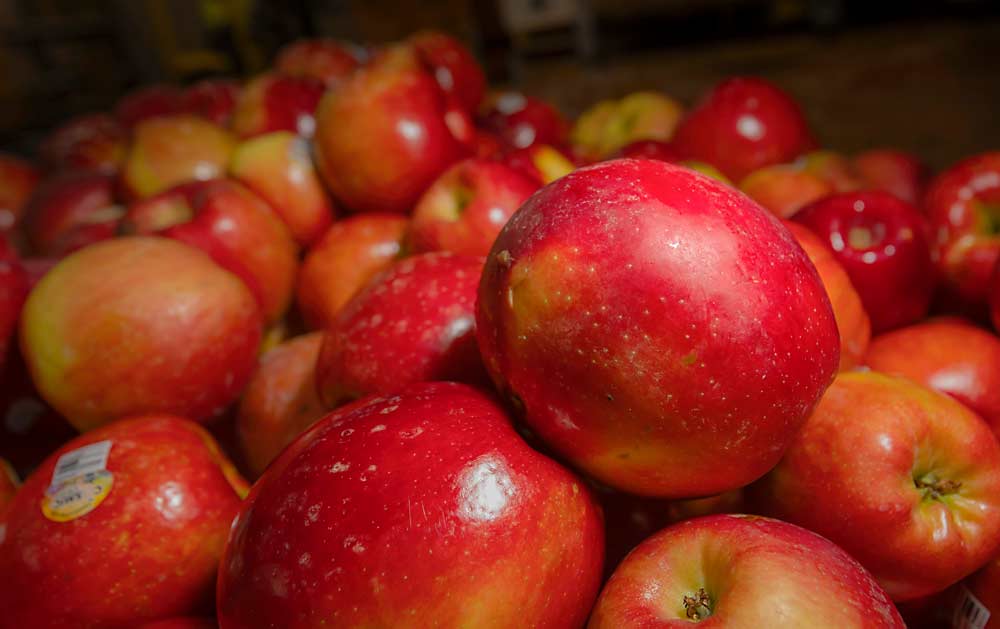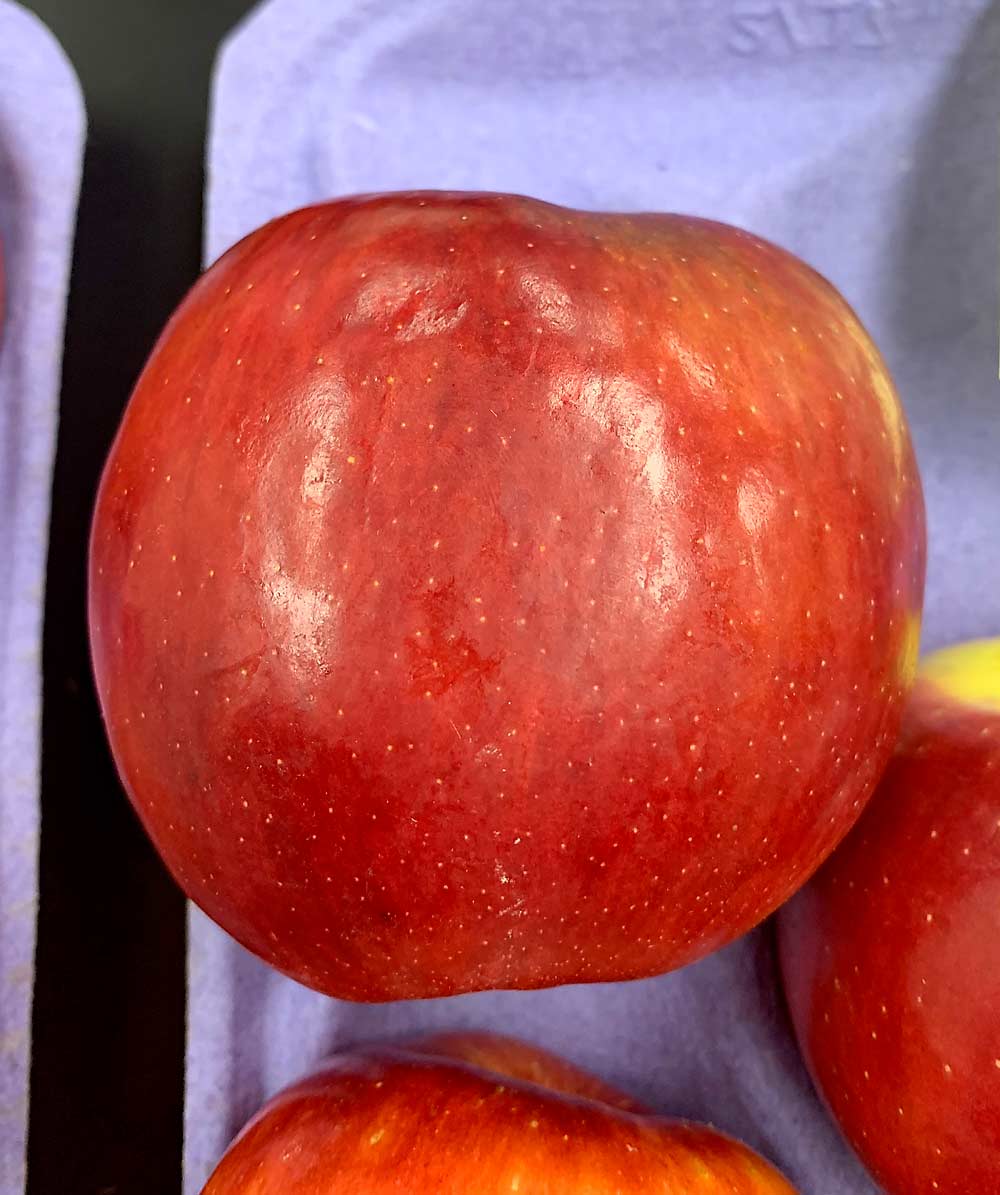
Editor’s note:
After this story was published in our September 2021 issue, we received the following clarification:
The Washington Tree Fruit Research Commission maintains their recommendation to target 2.0 on the starch scale developed by the research commission. Proprietary Variety Management’s quality standards committee extended the ideal range from 1.5 to 2.5 to help growers better capture orchard variability while aiming for 2.0, but the research commission still recommends a threshold of 2.0.
Pick those WA 38 apples just a little earlier and double-check the waxing station on the packing lines.
Those are the bits of advice from researchers studying how to avoid greasiness as growers gear up for their third commercial harvest of Washington State University’s proprietary apple, sold as Cosmic Crisp.
The past two years, packers have noticed the apple’s natural wax, usually called grease, oozing through line-applied waxes in some lots. Harvesting a tad earlier will help solve that, said Carolina Torres, WSU’s endowed chair for postharvest physiology.
“If you harvest a little bit too late, you might have a little bit of greasiness,” she said.
Torres also recommends packing line managers pay extra-close attention to the waxing portion of the line, making sure the apple has been cleaned of natural grease and sufficiently covered with the applied wax. If not, natural grease may seep through.
Also, as orchards mature, trees will stabilize and reduce the fruit’s greasiness tendencies, she said.

Each year since commercial launch in 2019, Proprietary Variety Management, or PVM, the Yakima company commercializing the Cosmic Crisp, has lowered the early end of its starch scale harvest guidelines, based on input from quality advisers and researchers. For 2021, the starch target range starts at 1.5, down from 2.0 last year and 2.5 in 2019.
“The quality standards committee decided to try to lower the harvest threshold just a little bit to keep the greasiness from developing,” said Jill Burbery of PVM.
The idea is that starch measurements represent a small sample, so having the threshold at 2.0 or 2.5 may have let some fruit inadvertently hang past the optimum maturity, Burbery said.
On the other end of the spectrum, to make sure those early-harvest WA 38s develop enough flavor in storage, PVM is now requiring shippers to let them clear 5.0 on the starch scale before shipping, which had always been the suggested level. The company has also hired a quality manager to step up enforcement of that threshold this year, Burbery said.
Adjusting standards as the industry learns more about the new apple was always part of the plan, Burbery said. To advise such decisions, PVM relies on the state’s fruit researchers, such as Torres, and a quality standards committee comprised of shippers.
Also at the committee’s suggestion this year, PVM has mandated grades of Washington Extra Fancy and U.S. Extra Fancy, a slight tightening in defect tolerance over Washington Fancy, the previous standard. It set better defined color standards, too, and provided visual indicators to help packers make the determination.
Fruit maturity
Torres based her conclusions on packer surveys after the 2020 harvest. Fruit maturity and attention to detail during waxing were the only patterns to emerge, she said. Storage length, 1-MCP treatments and firmness at harvest did not seem to affect the incidence of greasiness, according to the surveys, which represent about 25 percent of the state’s volume.
Greasiness concerns are hardly universal.
Washington Fruit and Produce Co. of Yakima has not struggled with greasiness, said Dan Plath, co-owner. In fact, during an April run, the company had trouble finding greasy apples to show Good Fruit Grower.
Plath credits his managers carefully following PVM’s harvest guidelines.
“We’re just doing what the researchers are telling us to do,” he said.
However, Washington Fruit did notice splitting in 2019, due to overripening. Lowering the starch threshold after that first year seemed to solve that problem, too, he said.
Field representatives for Double Diamond Fruit of Quincy run the starch tests, but they primarily schedule harvest around visual cues, asking growers to pick fruit the moment they see signs of greasiness, said Mike Robinson, company president. The sun-exposed fruit develops greasiness before the rest of the apples.
“We wait as long as we can, based on the appearance of the fruit, and try to get it before greasiness,” Robinson said. “That is a much narrower window than you would believe.”
Research continues. Torres would like to know other factors, besides fruit maturity, that correlate with greasiness, such as humidity or temperature. She is also in the midst of trials comparing alternative waxes to carnauba, the relatively permeable wax of choice for about 90 percent of the state’s apple packers, though she is not yet ready to discuss results.
But for now, Torres advises the industry to mind harvest timing and wax applications.
“Focus on the two things we can manage, the rest we cannot,” she said.
—by Ross Courtney
"fruit" - Google News
September 15, 2021 at 04:22AM
https://ift.tt/3hAy4kO
Timing is everything for Cosmic Crisp - Good Fruit Grower
"fruit" - Google News
https://ift.tt/2pWUrc9
https://ift.tt/3aVawBg
Bagikan Berita Ini














0 Response to "Timing is everything for Cosmic Crisp - Good Fruit Grower"
Post a Comment